Indexed in: ESCI, Scopus, PubMed,
PubMed Central, CAS, DOAJ, KCI
PubMed Central, CAS, DOAJ, KCI
FREE article processing charge

Previous issues
- Page Path
- HOME > Browse Articles > Previous issues
Review articles
- Pharmacologic therapy for nonalcoholic steatohepatitis focusing on pathophysiology
- In Cheol Yoon, Jong Ryeol Eun
- Yeungnam Univ J Med. 2019;36(2):67-77. Published online April 11, 2019
- DOI: https://doi.org/10.12701/yujm.2019.00171

- 9,640 View
- 203 Download
- 6 Crossref
-
 Abstract
Abstract
 PDF
PDF - The paradigm of chronic liver diseases has been shifting. Although hepatitis B and C viral infections are still the main causes of liver cirrhosis and hepatocellular carcinoma (HCC), the introduction of effective antiviral drugs may control or cure them in the near future. In contrast, the burden of nonalcoholic fatty liver disease (NAFLD) has been increasing for decades, and 25 to 30% of the general population in Korea is estimated to have NAFLD. Over 10% of NAFLD patients may have nonalcoholic steatohepatitis (NASH), a severe form of NAFLD. NASH can progress to cirrhosis and HCC. NASH is currently the second leading cause to be placed on the liver transplantation list in the United States. NAFLD is associated with obesity, type 2 diabetes, dyslipidemia, and metabolic syndrome. The pathophysiology is complex and associated with lipotoxicity, inflammatory cytokines, apoptosis, and insulin resistance. The only proven effective treatment is weight reduction by diet and exercise. However, this may not be effective for advanced fibrosis or cirrhosis. Therefore, effective drugs are urgently needed for treating these conditions. Unfortunately, no drugs have been approved for the treatment of NASH. Many pharmaceutical companies are trying to develop new drugs for the treatment of NASH. Some of them are in phase 2 or 3 clinical trials. Here, pharmacologic therapies in clinical trials, as well as the basic principles of drug therapy, will be reviewed, focusing on pathophysiology.
-
Citations
Citations to this article as recorded by- Unlocking the Therapeutic Potential of Ellagic Acid for Non-Alcoholic Fatty Liver Disease and Non-Alcoholic Steatohepatitis
Tharani Senavirathna, Armaghan Shafaei, Ricky Lareu, Lois Balmer
Antioxidants.2024; 13(4): 485. CrossRef - Mechanism of PANoptosis in metabolic dysfunction-associated steatotic liver disease
Keying Ni, Lina Meng
Clinics and Research in Hepatology and Gastroenterology.2024; 48(7): 102381. CrossRef - Effect of Lactobacillus rhamnosus hsryfm 1301 Fermented Milk on Lipid Metabolism Disorders in High-Fat-Diet Rats
Hengxian Qu, Lina Zong, Jian Sang, Yunchao Wa, Dawei Chen, Yujun Huang, Xia Chen, Ruixia Gu
Nutrients.2022; 14(22): 4850. CrossRef - Oxidative Stress Is a Key Modulator in the Development of Nonalcoholic Fatty Liver Disease
Yuanqiang Ma, Gyurim Lee, Su-Young Heo, Yoon-Seok Roh
Antioxidants.2021; 11(1): 91. CrossRef - Elevated 1-h post-load plasma glucose levels in normal glucose tolerance children with obesity is associated with early carotid atherosclerosis
Suna Kılınç, Tuna Demirbaş, Enver Atay, Ömer Ceran, Zeynep Atay
Obesity Research & Clinical Practice.2020; 14(2): 136. CrossRef - Pathophysiology of NAFLD and NASH in Experimental Models: The Role of Food Intake Regulating Peptides
L. Kořínková, V. Pražienková, L. Černá, A. Karnošová, B. Železná, J. Kuneš, Lenka Maletínská
Frontiers in Endocrinology.2020;[Epub] CrossRef
- Unlocking the Therapeutic Potential of Ellagic Acid for Non-Alcoholic Fatty Liver Disease and Non-Alcoholic Steatohepatitis
- Trends in the study on medical education over the last 10 years, based on paper titles
- Seong Yong Kim
- Yeungnam Univ J Med. 2019;36(2):78-84. Published online May 13, 2019
- DOI: https://doi.org/10.12701/yujm.2019.00206

- 5,173 View
- 109 Download
- 1 Crossref
-
 Abstract
Abstract
 PDF
PDF - Medical education research subjects are incredibly diverse and have changed over time. This work in particular aims to compare and analyze research trends in medical education through the words used in the titles of these research papers. Academic Medicine (the journal of the Association of American Medical Colleges), Medical Teacher (the journal of the Association of Medical Education in Europe), the Korean Journal of Medical Education (KJME), and Korean Medical Education Review (KMER) were selected and analyzed for the purposes of this research. From 2009 to 2018, Academic Medicine and Medical Teacher published approximately 10 to 20 times more papers than the KJME and KMER. Frequently used words in these titles include “medical,” “student,” “education,” and “learning.” The words “clinical” and “learning” were used relatively often (7.80% to 13.66%) in Korean Journals and Medical Teacher, but Academic Medicine used these phrases relatively less often (6.47% and 4.41%, respectively). Concern with such various topics as problem-based learning, team-based learning, program evaluations, burnout, e-learning, and digital indicates that Medical Teacher seems to primarily deal with teaching and learning methodologies, and Academic Medicine handles all aspects of medical education. The KJME and KMER did not cover all subjects, as they publish smaller papers. However, it is anticipated that research on new subjects, such as artificial intelligence in medical education, will occur in the near future.
-
Citations
Citations to this article as recorded by- Assessing the effectiveness of massive open online courses on improving clinical skills in medical education in China: A meta-analysis
Ling Yang, Jiao Zou, Junwei Gao, Xiaotang Fan
Heliyon.2023; 9(8): e19263. CrossRef
- Assessing the effectiveness of massive open online courses on improving clinical skills in medical education in China: A meta-analysis
- Endoscopic features aiding the diagnosis of gastric mucosa-associated lymphoid tissue lymphoma
- Byung Sam Park, Si Hyung Lee
- Yeungnam Univ J Med. 2019;36(2):85-91. Published online February 26, 2019
- DOI: https://doi.org/10.12701/yujm.2019.00136
- 10,076 View
- 213 Download
- 16 Crossref
-
 Abstract
Abstract
 PDF
PDF - The incidence of gastric mucosa-associated lymphoid tissue (MALT) lymphoma is increasing worldwide, but the diagnosis is difficult. Most patients are asymptomatic or complain of nonspecific gastrointestinal symptoms. As the endoscopic features of gastric MALT lymphoma are variable and nonspecific, the possibility of this condition may be overlooked during esophagogastroduodenoscopy, and it remain undiagnosed. Therefore, this condition needs to be considered when an abnormal mucosa is observed during this procedure. Biopsy performed during endoscopy is the primary diagnostic test, but false negative results are possible; large numbers of samples should be collected from both normal and abnormal mucosae. Endoscopic ultrasonography is useful to assess the depth of invasion and to predict the treatment response. After treatment, follow-up tests are required every 3 months until complete remission is achieved, and annually thereafter. Early diagnosis of gastric MALT lymphoma is difficult, and its diagnosis and follow-up require wide experience and competent endoscopic technique.
-
Citations
Citations to this article as recorded by- Эндоскопическая семиотика гастритоподобной формы первичных неходжкинских лимфом желудка
Валерия Витальевна Лозовая, О. А. Малихова, А. О. Туманян
Clinical Oncohematology.2024; 16(4): 380. CrossRef - Uncommon presentation of gastric mucosa-associated lymphoid tissue lymphoma in a 13-year-old girl: acute vomiting of blood as the initial symptom
Xinyu Jin, Xin Jin, Piao Guo, Linjuan Lu, Weisong Sheng, Danrong Zhu
Annals of Medicine & Surgery.2024; 86(5): 3001. CrossRef - Next-Generation-Sequencing of the Human B-Cell Receptor Improves Detection and Diagnosis and Enhances Disease Monitoring in Patients with Gastric Mucosa-Associated Lymphoid Tissue Lymphoma
Chidimma Agatha Akpa, Cora Husemann, Chris Allen, Ann-Christin von Brünneck, Jana Ihlow, Michael Hummel
Journal of Molecular Pathology.2024; 5(3): 292. CrossRef - A rare case of perforated gastric lymphoma presenting a life-threatening condition: A case report
Mohamed Zayati, Mohamed Ali Chaouch, Ahmed Hadj Taieb, Besma Gafsi, Mehdi Ben Abdelwahed, Faouzi Noomen
International Journal of Surgery Case Reports.2023; 112: 109010. CrossRef - Development and evaluation of a double-check support system using artificial intelligence in endoscopic screening for gastric cancer
Hirotaka Oura, Tomoaki Matsumura, Mai Fujie, Tsubasa Ishikawa, Ariki Nagashima, Wataru Shiratori, Mamoru Tokunaga, Tatsuya Kaneko, Yushi Imai, Tsubasa Oike, Yuya Yokoyama, Naoki Akizue, Yuki Ota, Kenichiro Okimoto, Makoto Arai, Yuki Nakagawa, Mari Inada,
Gastric Cancer.2022; 25(2): 392. CrossRef - Mucosa-associated lymphoid tissue lymphoma in the terminal ileum: A case report
Vitor Lauar Pimenta de Figueiredo, Igor Braga Ribeiro, Diogo Turiani Hourneaux de Moura, Cristiano Claudino Oliveira, Eduardo Guimarães Hourneaux de Moura
World Journal of Gastrointestinal Endoscopy.2022; 14(3): 176. CrossRef - Mucosa-associated lymphoid tissue lymphoma in the terminal ileum: A case report
Vitor Lauar Pimenta de Figueiredo, Igor Braga Ribeiro, Diogo Turiani Hourneaux de Moura, Cristiano Claudino Oliveira, Eduardo Guimarães Hourneaux de Moura
World Journal of Gastrointestinal Endoscopy.2022; 14(3): 177. CrossRef - Gastrointestinal Tract Lymphoma
Ji Yong Ahn
The Korean Journal of Helicobacter and Upper Gastrointestinal Research.2022; 22(1): 18. CrossRef - Mucosa-Associated Lymphoid Tissue Lymphoma Masked as Gastric Varices With Acute Upper Gastrointestinal Bleeding: A Case Report
David E Jonason, Michael Linden, Guru Trikudanathan
Cureus.2022;[Epub] CrossRef - Endoscopic submucosal dissection for protruding Helicobacter pylori-negative mucosa-associated lymphoid tissue lymphoma of the stomach: a case report
Mayuko Seya, Osamu Dohi, Katsuma Yamauchi, Hayato Fukui, Hajime Miyazaki, Takeshi Yasuda, Ken Inoue, Naohisa Yoshida, Yukiko Morinaga, Yoshito Itoh
Clinical Journal of Gastroenterology.2022; 15(5): 881. CrossRef - Multimodality imaging findings of infection-induced tumors
Moataz Soliman, Nicholas Guys, Peter Liu, Mariam Moshiri, Christine O. Menias, Vincent M. Mellnick, Hatice Savas, Mohamed Badawy, Khaled M. Elsayes, Ayman H. Gaballah
Abdominal Radiology.2022; 47(11): 3930. CrossRef - Does endoscopic submucosal dissection have its place in the treatment of patients with gastric mucosa associated lymphoid tissue lymphoma localized disease after eradication?
Y Li, Z Wang, X Zhang, J Yang
Acta Gastro Enterologica Belgica.2022; 85(2): 410. CrossRef - Multiple Synchronous Mucosa-Associated Lymphoid Lymphomas Involving in the Stomach, Duodenum, Ileum, and Sigmoid
Chun-Wei Chen, Yang-Yuan Chen, Yung-Fang Chen
Diagnostics.2022; 12(12): 3150. CrossRef - Gastric Mucosa-Associated Lymphoid Tissue Lymphomas Diagnosed by Jumbo Biopsy Using Endoscopic Submucosal Dissection: A Case Report
Jian Han, Jun Wang, Hua-ping Xie
Frontiers in Medicine.2021;[Epub] CrossRef - Pedunculated mucosa-associated lymphoid tissue (MALT) lymphoma causing gastric outlet obstruction
Elena Resina Sierra, Pablo Miranda García, Magdalena Adrados, Cecilio Santander Vaquero
Revista Española de Enfermedades Digestivas.2021;[Epub] CrossRef - Primary mucosal-associated lymphoid tissue extranodal marginal zone lymphoma of the bladder from an imaging perspective: A case report
Zhen-Zhen Jiang, Yuan-Yuan Zheng, Chuan-Ling Hou, Xia-Tian Liu
World Journal of Clinical Cases.2021; 9(32): 10024. CrossRef
- Эндоскопическая семиотика гастритоподобной формы первичных неходжкинских лимфом желудка
- Forefoot disorders and conservative treatment
- Chul Hyun Park, Min Cheol Chang
- Yeungnam Univ J Med. 2019;36(2):92-98. Published online May 14, 2019
- DOI: https://doi.org/10.12701/yujm.2019.00185
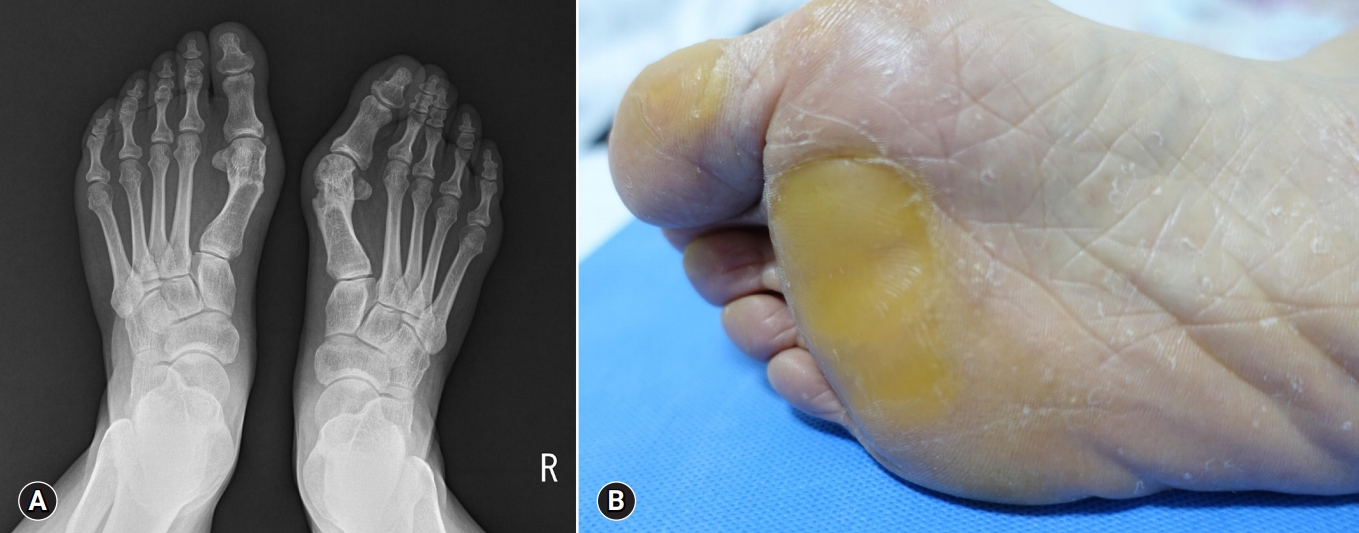
- 17,405 View
- 460 Download
- 31 Crossref
-
 Abstract
Abstract
 PDF
PDF - Forefoot disorders are often seen in clinical practice. Forefoot deformity and pain can deteriorate gait function and decrease quality of life. This review presents common forefoot disorders and conservative treatment using an insole or orthosis. Metatarsalgia is a painful foot condition affecting the metatarsal (MT) region of the foot. A MT pad, MT bar, or forefoot cushion can be used to alleviate MT pain. Hallux valgus is a deformity characterized by medial deviation of the first MT and lateral deviation of the hallux. A toe spreader, valgus splint, and bunion shield are commonly applied to patients with hallux valgus. Hallux limitus and hallux rigidus refer to painful limitations of dorsiflexion of the first metatarsophalangeal joint. A kinetic wedge foot orthosis or rocker sole can help relieve symptoms from hallux limitus or rigidus. Hammer, claw, and mallet toes are sagittal plane deformities of the lesser toes. Toe sleeve or padding can be applied over high-pressure areas in the proximal or distal interphalangeal joints or under the MT heads. An MT off-loading insole can also be used to alleviate symptoms following lesser toe deformities. Morton’s neuroma is a benign neuroma of an intermetatarsal plantar nerve that leads to a painful condition affecting the MT area. The MT bar, the plantar pad, or a more cushioned insole would be useful. In addition, patients with any of the above various forefoot disorders should avoid tight-fitting or high-heeled shoes. Applying an insole or orthosis and wearing proper shoes can be beneficial for managing forefoot disorders.
-
Citations
Citations to this article as recorded by- Influencia de la fotografía preoperatoria en el grado de satisfacción en pacientes postoperados de cirugía de antepié
N. Boó Gustems, J.D. Molano Castro, L. López-Capdevila, M.C. Castro Álvarez, E.A. Muñoz Ruano, A. Domínguez Sevilla, J. Román Verdasco, A. Santamaria Fumas, J.M. Sales Pérez, A.K. Sanchez Hukiyama
Revista Española de Cirugía Ortopédica y Traumatología.2024; 68(3): 247. CrossRef - The effects of the use of customized silicone digital orthoses on pre-ulcerative lesions and plantar pressure during walking in people with diabetic neuropathy: A study protocol for a randomized controlled trial
Maria L.S. Lucoveis, Mônica Gamba, Erica Queiroz Silva, Letícia A.S. Pinto, Isabel C.N. Sacco
Contemporary Clinical Trials Communications.2024; 37: 101247. CrossRef - [Translated article] The effect of showing preoperative photographs on patient satisfaction following forefoot surgery
N. Boó Gustems, J.D. Molano Castro, L. López-Capdevila, M.C. Castro Álvarez, E.A. Muñoz Ruano, A. Domínguez Sevilla, J. Román Verdasco, A. Santamaria Fumas, J.M. Sales Pérez, A.K. Sanchez Hukiyama
Revista Española de Cirugía Ortopédica y Traumatología.2024; 68(3): T247. CrossRef - Orthotics for the Treatment of Lesser Toe Deformities
Manuel Monteagudo, Ángel M. Orejana
Foot and Ankle Clinics.2024;[Epub] CrossRef - Differences and Similarities in the Feet of Metatarsalgia Patients with and without Rheumatoid Arthritis in Remission
Rebeca Bueno Fermoso, Maria Rosario Morales Lozano, Marta Nieto Cordero, Carmen Martínez Rincón, Pablo García-Fernández, María Luz González Fernández
Journal of Clinical Medicine.2024; 13(10): 2881. CrossRef - Treatment of Lesser Toe Deformities Based on Physical Therapy
Pérola Grinberg Plapler, Dai Ling
Foot and Ankle Clinics.2024;[Epub] CrossRef - The efficacy of shoes modification and orthotics in hallux valgus deformity: a comprehensive review of literature
G. Colò, M. Leigheb, M. F. Surace, F. Fusini
MUSCULOSKELETAL SURGERY.2024;[Epub] CrossRef - Hallux Valgus Nonunion Correction in an Active Duty Military Member
Aryan Rezvani, Kiya Shazadeh Safavi, Todd A Fellars, Cory F Janney
Military Medicine.2023; 188(5-6): e1341. CrossRef - Deep-Learning Algorithms for Prescribing Insoles to Patients with Foot Pain
Jeoung Kun Kim, Yoo Jin Choo, In Sik Park, Jin-Woo Choi, Donghwi Park, Min Cheol Chang
Applied Sciences.2023; 13(4): 2208. CrossRef - Morton’s Extension on Hallux Rigidus Pathology
Rubén Sánchez-Gómez, Juan Manuel López-Alcorocho, Almudena Núñez-Fernández, María Luz González Fernández, Carlos Martínez-Sebastián, Ismael Ortuño-Soriano, Ignacio Zaragoza-García, Álvaro Gómez-Carrión
Prosthesis.2023; 5(1): 251. CrossRef - Cinderella’s misery: The wretched human foot
Cem Turaman
The Foot.2023; 56: 101983. CrossRef - Differential Diagnosis of Metatarsalgia
P. Diana Afonso, Sabrina Veras Britto, Charles E. Spritzer, Patrícia Martins e Souza
Seminars in Musculoskeletal Radiology.2023; 27(03): 337. CrossRef - Severe hallux valgus can be treated using a distal metatarsal osteotomy: Results of 144 cases treated with the SERI technique
Antonio Mazzotti, Simone Ottavio Zielli, Pejman Abdi, Elena Artioli, Alberto Arceri, Francesca Vannini, Cesare Faldini
Foot and Ankle Surgery.2023; 29(6): 455. CrossRef - Treatment of a patient with chronic causalgia after surgical removal of the neuroma in the second interdigital space
Daria A. Bolshakova, Andrey A. Kardanov, Musa N. Maysigov, Andrey V. Korolev
N.N. Priorov Journal of Traumatology and Orthopedics.2023; 30(3): 347. CrossRef - Assessment and indicators of hallux limitus related with quality of life and foot health in school children
Claudia Cuevas-Martínez, Ricardo Becerro-de-Bengoa-Vallejo, Marta Elena Losa-Iglesias, Emmanuel Navarro-Flores, Laura Pérez-Palma, João Martiniano, Daniel López-López, Israel Casado-Hernández, Juan Gómez-Salgado
Frontiers in Pediatrics.2023;[Epub] CrossRef - The videos on YouTube® related to hallux valgus surgery have insufficient information
Metin Uzun, Tunca Cingoz, Mehmet Emin Duran, Ali Varol, Haluk Celik
Foot and Ankle Surgery.2022; 28(4): 414. CrossRef - Diabetic Ulcer Prevention
Melanie M. Lyon
Physician Assistant Clinics.2022; 7(1): 13. CrossRef - Effects of Custom-made Insoles on Plantar Biomechanics and Upper Extremity Muscle Performance
Yi Xu, Qing-hua Hou, Xiu-lan Han, Chu-huai Wang, Dong-feng Huang
Current Medical Science.2022; 42(1): 159. CrossRef - Clinical evaluation of an innovative nerve termination cap for treatment and prevention of stump neuroma pain: Results from a prospective pilot clinical study
Ryan Pereira, Damien Dauphinee, Stephen Frania, Alan Garrett, Craig Martin, Carl Van Gils, Craig Thomajan
Foot & Ankle Surgery: Techniques, Reports & Cases.2022; 2(2): 100179. CrossRef - Pathophysiological Behaviour of the Climber’s Foot versus the General Population: A Prospective Observational Study
Paula Cobos-Moreno, Álvaro Astasio-Picado, Beatriz Gómez-Martín
Healthcare.2022; 10(5): 868. CrossRef - Selected hallmarks of hallux valgus in older women with symptomatic hallux valgus compared to middle-aged women with and without deformation of the forefoot
Agnieszka Jankowicz-Szymańska, Katarzyna Wódka, Marta Bibro, Eliza Smoła, Aneta Bac
Scientific Reports.2022;[Epub] CrossRef - Impact of a dynamic ankle orthosis on acute pain and function in patients with mechanical foot and ankle pain
Chloe L. Chung, Max R. Paquette, Denis J. DiAngelo
Clinical Biomechanics.2021; 83: 105281. CrossRef - Effects of Balance Shoes on Balance and Postural Stability in the Elderly: A Crossover, Controlled, Randomized Single-Blind Study
Nicolas Amiez, Carole Cometti, Éric Mouillon, Marie José Teisseire, Pascal Chenut, Christos Paizis, Nicolas Babault
Healthcare.2021; 9(2): 179. CrossRef - Diagnosis and conservative management of great toe pathologies: a review
Nicholas A. Andrews, Jessyca Ray, Aseel Dib, Whitt M. Harrelson, Ankit Khurana, Maninder Shah Singh, Ashish Shah
Postgraduate Medicine.2021; 133(4): 409. CrossRef - Evaluating the Symmetry in Plantar Pressure Distribution under the Toes during Standing in a Postural Pedobarographic Examination
Karolina Gawronska, Jacek Lorkowski
Symmetry.2021; 13(8): 1476. CrossRef - Effects of rocker radii with two longitudinal bending stiffnesses on plantar pressure distribution in the forefoot
I.Y. ten Wolde, L. van Kouwenhove, R. Dekker, J.M. Hijmans, C. Greve
Gait & Posture.2021; 90: 457. CrossRef - A Concurrent Plantar Stress Sensing and Energy Harvesting Technique by Piezoelectric Insole Device and Rectifying Circuitry
Junliang Chen, Yanning Dai, Shuaibo Kang, Lijun Xu, Shuo Gao
IEEE Sensors Journal.2021; 21(23): 26364. CrossRef - Seated Virtual Reality-Guided Exercise Improved Gait in a Postoperative Hallux Valgus Case
Masami Nakamoto, Akihiro Kakuda, Toshinori Miyashita, Takashi Kitagawa, Masashi Kitano, Masahiko Hara, Shintarou Kudo
International Journal of Environmental Research and Public Health.2021; 18(24): 13267. CrossRef - Reducción de las presiones plantares dinámicas en un calcetín experimental. Un estudio preliminar
Juan Miguel Caracuel López, Raquel Sánchez Rodríguez, Beatriz Gómez-Martín, Elena Escamilla-Martínez , Alfonso Martínez Nova, Víctor Manuel Jiménez Cano
Revista Española de Podología.2021;[Epub] CrossRef - Metatarsalgia
Francisco Vargas Negrín
FMC - Formación Médica Continuada en Atención Primaria.2020; 27(3): 139. CrossRef - A Rare Case of Lateral Forefoot Pain: Plantar Adventitious Bursitis
Min Cheol Chang, Wei-Ting Wu, Ke-Vin Chang
Cureus.2020;[Epub] CrossRef
- Influencia de la fotografía preoperatoria en el grado de satisfacción en pacientes postoperados de cirugía de antepié
Original articles
- Efficacy of ramosetron in combination with polyethylene glycol of preparing for a colonoscopy
- Min Kyu Kang, Byung Ik Jang, Jun Suk Park, Kyeong Ok Kim
- Yeungnam Univ J Med. 2019;36(2):99-104. Published online December 28, 2018
- DOI: https://doi.org/10.12701/yujm.2019.00080

- 5,121 View
- 94 Download
- 1 Crossref
-
 Abstract
Abstract
 PDF
PDF - Background
Because of its efficacy and safety, polyethylene glycol (PEG) is generally used to prepare for colonoscopy. However, the side effects of PEG, including nausea, vomiting, abdominal discomfort, pain, and general weakness, tend to decrease patient compliance and satisfaction. The aim of this study is to investigate the efficacy and safety of PEG with 0.1 mg ramosetron on colonoscopy patients who had difficulty taking PEG due to side effects or large volume.
Methods
From January to August in 2012, 28 patients who visited Yeungnam University hospital for a colonoscopy were prospectively enrolled. All enrolled patients were previous history underwent colonoscopy using PEG only in our hospital. The efficacy and safety of ramosetron were assessed through the use of a questionnaire, and compared previous bowel preparation.
Results
Compared to previous examination, the patients using the ramosetron reported less nausea, vomiting, abdominal discomfort, and abdominal pain, as well as a higher degree of compliance and satisfaction of the patient. There were no side effects reported with the use of ramosetron. However, overall bowel preparation quality was not better than the previous examination.
Conclusion
In case of the use of ramosetron in combination with PEG for bowel preparation, patients experienced a higher rate of compliance and tolerance. Looking forward, ramosetron may become an option of pretreatment for bowel preparation. -
Citations
Citations to this article as recorded by- Tolerance to colonoscopy preparation with Fortrans and predictors of negative effects
I. A. Matveev, B. K. Gibert, A. I. Matveev, M. P. Kozlov
Bulletin of Siberian Medicine.2021; 20(1): 83. CrossRef
- Tolerance to colonoscopy preparation with Fortrans and predictors of negative effects
- Impact of calcineurin inhibitors on rat glioma cells viability
- Jeong Hun Seong, Woo Yeong Park, Jin Hyuk Paek, Sung Bae Park, Seungyeup Han, Kyo-Cheol Mun, Kyubok Jin
- Yeungnam Univ J Med. 2019;36(2):105-108. Published online January 21, 2019
- DOI: https://doi.org/10.12701/yujm.2019.00108
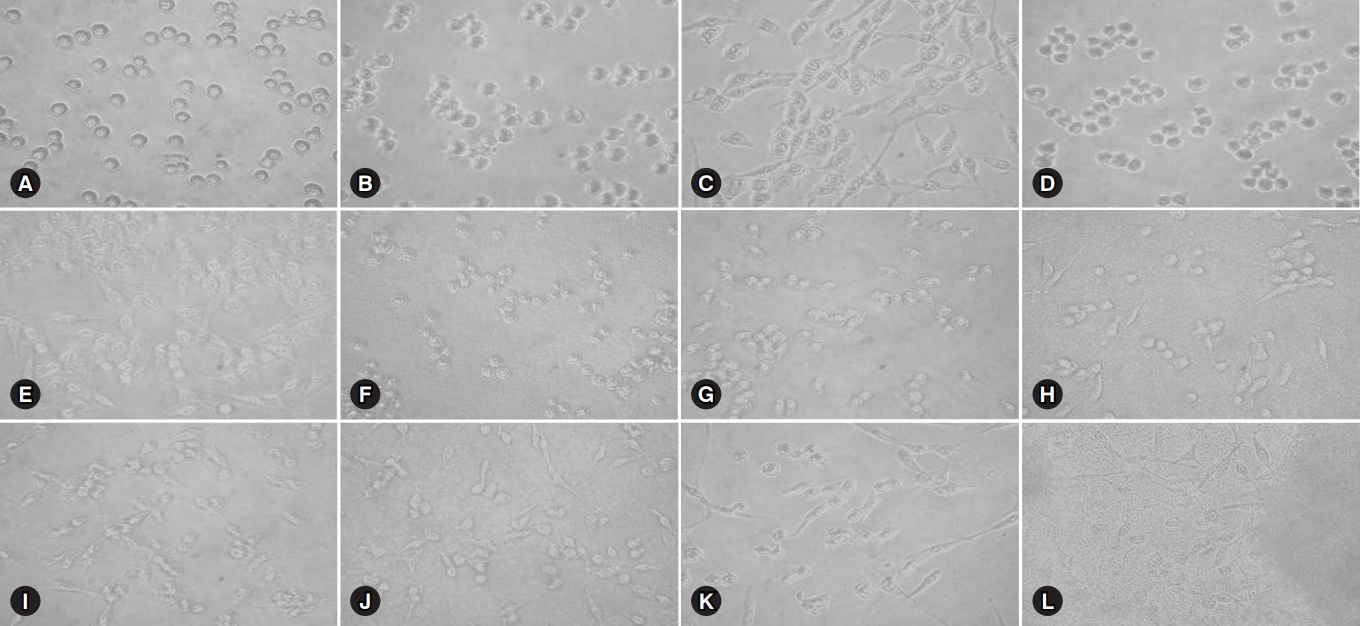
- 4,648 View
- 73 Download
- 1 Crossref
-
 Abstract
Abstract
 PDF
PDF - Background
Although kidney transplantation outcomes have improved dramatically after using calcineurin inhibitors (CNIs), CNI toxicity continues to be reported and the mechanism remains uncertain. Here, we investigated the neurotoxicity of CNIs by focusing on the viability of glioma cells.
Methods
Glioma cells were treated with several concentrations of CNIs for 24 hours at 37 ℃ and their cell viability was evaluated using 3-(4,5-dimethylthiazol-2-yl)-2,5-diphenyltetrazolium bromide assay.
Results
Exposure to 0, 0.25, 0.5, 2.5, 5.0, and 10.0 mM concentrations respectively showed 100%, 64.3%, 61.3%, 68.1%, 62.4%, and 68.6% cell viability for cyclosporine and 100%, 38.6%, 40.8%, 43.7%, 37.8%, and 43.0% for tacrolimus. The direct toxic effect of tacrolimus on glioma cell viability was stronger than that of cyclosporine at the same concentration.
Conclusion
CNIs can cause neurological side effects by directly exerting cytotoxic effects on brain cells. Therefore, we should carefully monitor the neurologic symptoms and level of CNIs in kidney transplant patients. -
Citations
Citations to this article as recorded by- Tacrolimus-Induced Neurotoxicity After Transplant: A Literature Review
Paige Verona, Jocelyn Edwards, Kassidy Hubert, Federica Avorio, Vincenzina Lo Re, Roberta Di Stefano, Anna Carollo, Heather Johnson, Alessio Provenzani
Drug Safety.2024; 47(5): 419. CrossRef
- Tacrolimus-Induced Neurotoxicity After Transplant: A Literature Review
- Digital subtraction angiography vs. real-time fluoroscopy for detection of intravascular injection during transforaminal epidural block
- Kibeom Park, Saeyoung Kim
- Yeungnam Univ J Med. 2019;36(2):109-114. Published online January 24, 2019
- DOI: https://doi.org/10.12701/yujm.2019.00122
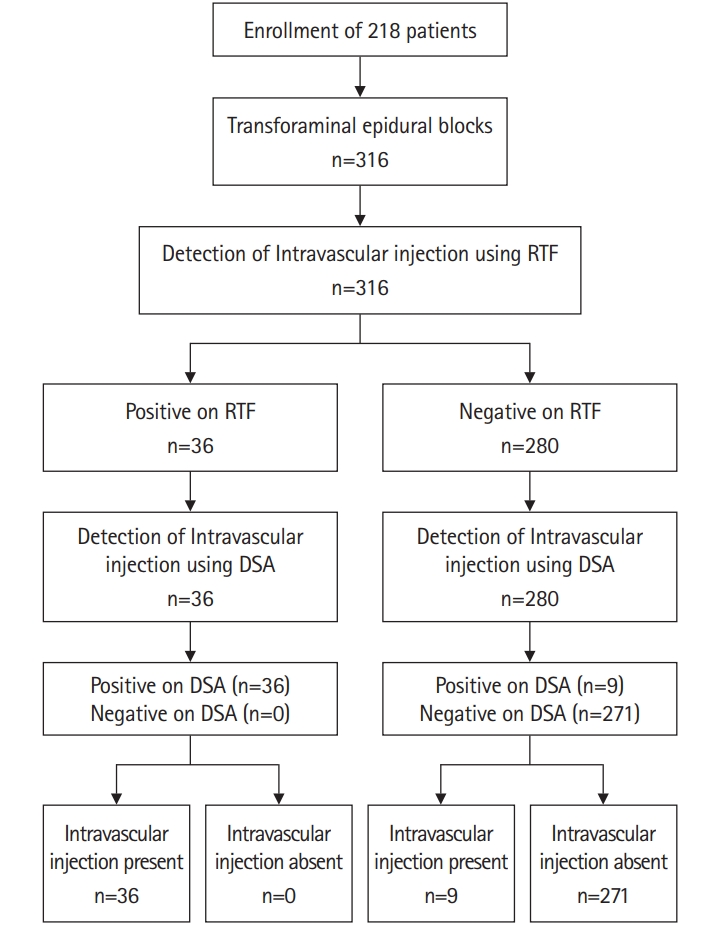
- 5,553 View
- 94 Download
- 5 Crossref
-
 Abstract
Abstract
 PDF
PDF - Background
Transforaminal epidural block (TFEB) is an effective treatment option for radicular pain. To reduce complications from intravascular injection during TFEB, use of imaging modalities such as real-time fluoroscopy (RTF) or digital subtraction angiography (DSA) has been recommended. In this study, we investigated whether DSA improved the detection of intravascular injection during TFEB at the whole spine level compared to RTF.
Methods
We prospectively examined 316 patients who underwent TFEB. After confirmation of final needle position using biplanar fluoroscopy, 2 mL of nonionic contrast medium was injected at a rate of 0.5 mL/s under RTF; 30 s later, 2 mL of nonionic contrast medium was injected at a rate of 0.5 mL/s under DSA.
Results
Thirty-six intravascular injections were detected for an overall rate of 11.4% using RTF, with 45 detected for a rate of 14.2% using DSA. The detection rate using DSA was statistically different from that using RTF (p=0.004). DSA detected a significantly higher proportion of intravascular injections at the cervical level than at the thoracic (p=0.009) and lumbar (p=0.011) levels.
Conclusion
During TFEB at the whole spine level, DSA was better than RTF for the detection of intravascular injection. Special attention is advised for cervical TFEB, because of a significantly higher intravascular injection rate at this level than at other levels. -
Citations
Citations to this article as recorded by- 1. Lumbosacral radicular pain
Laurens Peene, Steven P. Cohen, Jan Willem Kallewaard, Andre Wolff, Frank Huygen, Antal van de Gaag, Steegers Monique, Kris Vissers, Chris Gilligan, Jan Van Zundert, Koen Van Boxem
Pain Practice.2024; 24(3): 525. CrossRef - Safety of local anesthetics in cervical nerve root injections: a narrative review
Zachary E. Stewart
Skeletal Radiology.2023; 52(10): 1893. CrossRef - An update on technical and safety practice patterns in transforaminal epidural steroid injections
Ashley E. Gureck, Berkenesh Gebrekristos, Razvan Turcu, Dana Kotler, Alec L. Meleger
Interventional Pain Medicine.2023; 2(4): 100286. CrossRef - Thoracic transforaminal epidural steroid injection for management of thoracic spine pain: A multicenter cross-sectional study of short-term outcomes
Josh Levin, John Chan, Lisa Huynh, Matt Smuck, Jayme Koltsov, Bilge Kesikburun, Graham E. Wagner, Marc Caragea, Keith Kuo, Zachary L. McCormick, Byron Schneider, Evan Berlin, D.J. Kennedy, Serdar Kesikburun
Interventional Pain Medicine.2022; 1(1): 100004. CrossRef - The American Society of Pain and Neuroscience (ASPN) Best Practices and Guidelines for the Interventional Management of Cancer-Associated Pain
Mansoor M Aman, Ammar Mahmoud, Timothy Deer, Dawood Sayed, Jonathan M Hagedorn, Shane E Brogan, Vinita Singh, Amitabh Gulati, Natalie Strand, Jacqueline Weisbein, Johnathan H Goree, Fangfang Xing, Ali Valimahomed, Daniel J Pak, Antonios El Helou, Priyanka
Journal of Pain Research.2021; Volume 14: 2139. CrossRef
- 1. Lumbosacral radicular pain
- Clinical significance of lymph node size in locally advanced cervical cancer treated with concurrent chemoradiotherapy
- Jinju Oh, Ki Ho Seol, Youn Seok Choi, Jeong Won Lee, Jin Young Bae
- Yeungnam Univ J Med. 2019;36(2):115-123. Published online February 21, 2019
- DOI: https://doi.org/10.12701/yujm.2019.00143
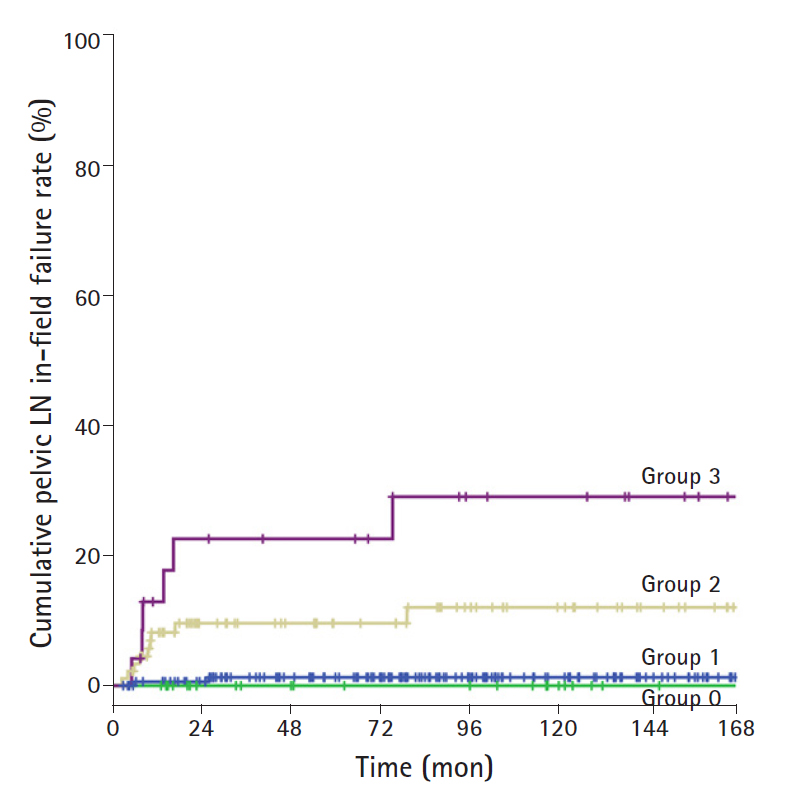
- 7,064 View
- 95 Download
- 8 Crossref
-
 Abstract
Abstract
 PDF
PDF - Background
This study aimed to assess the in-field lymph node (LN) failure rate according to LN size and to investigate effect of LN size on the survival outcome of patients with locally advanced cervical carcinoma treated with concurrent chemoradiotherapy (CCRT).
Methods
A total of 310 patients with locally advanced cervical carcinoma treated with CCRT were enrolled in retrospective study. LN status was evaluated by magnetic resonance imaging. All patients received conventional external beam irradiation and high-dose rate brachytherapy, and concurrent cisplatin-based chemotherapy. In-field LN failure rate according to LN size was analyzed.
Results
The median follow-up period was 83 months (range, 3-201 months). In-field LN failure rate in patients with pelvic LN size more than 10 mm was significantly higher than that in patients with pelvic LN size less than 10 mm (p<0.001). A similar finding was observed in the in-field para-aortic LN failure rate (p=0.024). The pelvic and para-aortic LN size (≥10 mm) was a significant prognostic factor of overall-survival (OS) and disease-free survival rate in univariate and multivariate analyses. The OS rate was significantly different between groups according to LN size (<10 mm vs. ≥10 mm).
Conclusion
A LN of less than 10 mm in size in an imaging study is controlled by CCRT. On the other hand, in LN of more than 10 mm in size, the in-field LN failure rate increase and the prognosis deteriorate. Therefore, a more aggressive treatment strategy is needed. -
Citations
Citations to this article as recorded by- Therapeutic effects of surgical debulking of metastatic lymph nodes in cervical cancer IIICr: a trial protocol for a phase III, multicenter, randomized controlled study (KGOG1047/DEBULK trial)
Bo Seong Yun, Kwang-Beom Lee, Keun Ho Lee, Ha Kyun Chang, Joo-Young Kim, Myong Cheol Lim, Chel Hun Choi, Hanbyoul Cho, Dae-Yeon Kim, Yun Hwan Kim, Joong Sub Choi, Chae Hyeong Lee, Jae-Weon Kim, Sang Wun Kim, Yong Bae Kim, Chi-Heum Cho, Dae Gy Hong, Yong J
Journal of Gynecologic Oncology.2024;[Epub] CrossRef - Can we triumph over locally advanced cervical cancer with colossal para-aortic lymph nodes? A case report
Abdulla Alzibdeh, Issa Mohamad, Lina Wahbeh, Ramiz Abuhijlih, Fawzi Abuhijla
World Journal of Clinical Cases.2024; 12(10): 1851. CrossRef - RECIST 1.1 versus clinico-radiological response assessment for locally advanced cervical cancer: implications on interpreting survival outcomes of future trials
Mayuri Charnalia, Supriya Chopra, Jaahid Mulani, Palak Popat, Sushmita Rath, Maarten Thomeer, Prachi Mittal, Ankita Gupta, Ingrid Boere, Sudeep Gupta, Remi A Nout
International Journal of Gynecologic Cancer.2024; : ijgc-2024-005336. CrossRef - Efficacy of lymph node dissection on stage IIICr of cervical cancer before CCRT: study protocol for a phase III, randomized controlled clinical trial (CQGOG0103)
Misi He, Mingfang Guo, Qi Zhou, Ying Tang, Lin Zhong, Qing Liu, Xiaomei Fan, Xiwa Zhao, Xiang Zhang, Gang Chen, Yuanming Shen, Qin Xu, Xiaojun Chen, Yuancheng Li, Dongling Zou
Journal of Gynecologic Oncology.2023;[Epub] CrossRef - Stadializarea clinică şi chirurgicală a pacientelor cu cancer de col uterin – studiu retrospectiv privind corelaţiile dintre diagnosticul iniţial, opţiunile de tratament şi rezultatele histopatologice
Mihai-Cristian Dumitraşcu, Adina-Elena Nenciu, Cătălin George Nenciu, Carmen Ursu, Andreea Ilieşiu, Alexandru Baroş, Diana Secară, Monica Mihaela Cîrstoiu
Ginecologia.ro.2023; 1(39): 30. CrossRef - Treatment of bulky lymph nodes in locally advanced cervical cancer: boosting versus debulking
Ester Paulien Olthof, Hans Wenzel, Jacobus van der Velden, Anje M Spijkerboer, Ruud Bekkers, Jogchum J Beltman, Hans W Nijman, Brigitte Slangen, Ramon Smolders, Nienke van Trommel, Petra L M Zusterzeel, Ronald Zweemer, Lukas J A Stalpers, Maaike van der A
International Journal of Gynecologic Cancer.2022; 32(7): 861. CrossRef - Targetability of cervical cancer by magnetic resonance-guided high-intensity focused ultrasound (MRgHIFU)-mediated hyperthermia (HT) for patients receiving radiation therapy
Lifei Zhu, Yi Huang, Dao Lam, H. Michael Gach, Imran Zoberi, Dennis E. Hallahan, Perry W. Grigsby, Hong Chen, Michael B. Altman
International Journal of Hyperthermia.2021; 38(1): 498. CrossRef - Surgical versus clinical staging prior to primary chemoradiation in patients with cervical cancer FIGO stages IIB–IVA: oncologic results of a prospective randomized international multicenter (Uterus-11) intergroup study
Simone Marnitz, Audrey Tieko Tsunoda, Peter Martus, Marcelo Vieira, Renato Jose Affonso Junior, João Nunes, Volker Budach, Hermann Hertel, Alexander Mustea, Jalid Sehouli, Jens-Peter Scharf, Uwe Ulrich, Andreas Ebert, Iris Piwonski, Christhardt Kohler
International Journal of Gynecologic Cancer.2020; 30(12): 1855. CrossRef
- Therapeutic effects of surgical debulking of metastatic lymph nodes in cervical cancer IIICr: a trial protocol for a phase III, multicenter, randomized controlled study (KGOG1047/DEBULK trial)
- What are the most important prognostic factors in patients with residual rectal cancer after preoperative chemoradiotherapy?
- Sol-Min Kim, Ghilsuk Yoon, An Na Seo
- Yeungnam Univ J Med. 2019;36(2):124-135. Published online April 1, 2019
- DOI: https://doi.org/10.12701/yujm.2019.00157
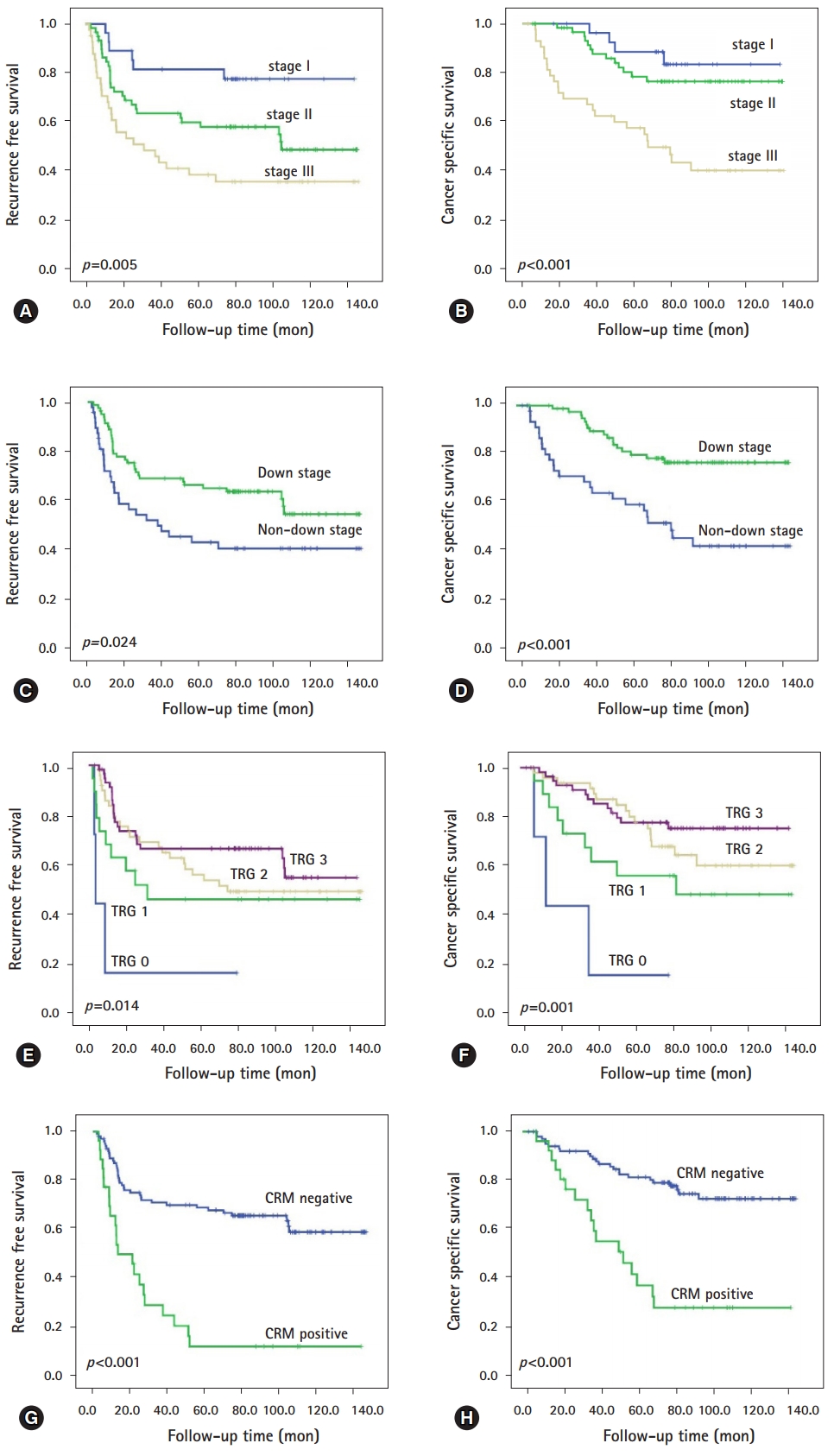
- 6,373 View
- 80 Download
- 3 Crossref
-
 Abstract
Abstract
 PDF
PDF - Background
We aimed to establish robust histoprognostic predictors on residual rectal cancer after preoperative chemoradiotherapy (CRT).
Methods
Analyzing known histoprognostic factors in 146 patients with residual disease allows associations with patient outcome to be evaluated.
Results
The median follow-up time was 77.8 months, during which 59 patients (40.4%) experienced recurrence and 41 (28.1%) died of rectal cancer. On univariate analysis, residual tumor size, ypT category, ypN category, ypTNM stage, downstage, tumor regression grade, lymphatic invasion, perineural invasion, venous invasion, and circumferential resection margin (CRM) were significantly associated with recurrence free survival (RFS) or/and cancer-specific survival (CSS) (all p<0.005). On multivariate analysis, higher ypTNM stage and CRM positivity were identified as independent prognostic factors for RFS (ypTNM stage, p=0.024; CRM positivity, p<0.001) and CSS (p=0.022, p=0.017, respectively). Furthermore, CRM positivity was an independent predictor of reduced RFS, irrespective of subgrouping according to downstage (non-downstage, p=0.001; downstage, p=0.010) or lymph node metastasis (non-metastasis, p=0.004; metastasis, p=0.007).
Conclusion
CRM status may be as powerful as ypTNM stage as a prognostic indicator for patient outcome in patients with residual rectal cancer after preoperative CRT. -
Citations
Citations to this article as recorded by- Poor nutrition and sarcopenia are related to systemic inflammatory response in patients with rectal cancer undergoing preoperative chemoradiotherapy
Shinya Abe, Hiroaki Nozawa, Kazushige Kawai, Kazuhito Sasaki, Koji Murono, Shigenobu Emoto, Junko Kishikawa, Tsuyoshi Ozawa, Yuichiro Yokoyama, Yuzo Nagai, Hiroyuki Anzai, Hirofumi Sonoda, Soichiro Ishihara
International Journal of Colorectal Disease.2022; 37(1): 189. CrossRef - Preoperative sarcopenia is a poor prognostic factor in lower rectal cancer patients undergoing neoadjuvant chemoradiotherapy: a retrospective study
Shinya Abe, Kazushige Kawai, Hiroaki Nozawa, Kazuhito Sasaki, Koji Murono, Shigenobu Emoto, Junko Kishikawa, Hiroaki Ishii, Yuichiro Yokoyama, Yuzo Nagai, Hiroyuki Anzai, Hirofumi Sonoda, Koji Oba, Soichiro Ishihara
International Journal of Clinical Oncology.2022; 27(1): 141. CrossRef - A Four-Methylated lncRNAs-Based Prognostic Signature for Hepatocellular Carcinoma
Le-En Liao, Dan-Dan Hu, Yun Zheng
Genes.2020; 11(8): 908. CrossRef
- Poor nutrition and sarcopenia are related to systemic inflammatory response in patients with rectal cancer undergoing preoperative chemoradiotherapy
- Factors affecting complications after treatment of epidermal cyst
- Man Ki Choi, Kyu Jin Chung
- Yeungnam Univ J Med. 2019;36(2):136-140. Published online April 1, 2019
- DOI: https://doi.org/10.12701/yujm.2019.00164
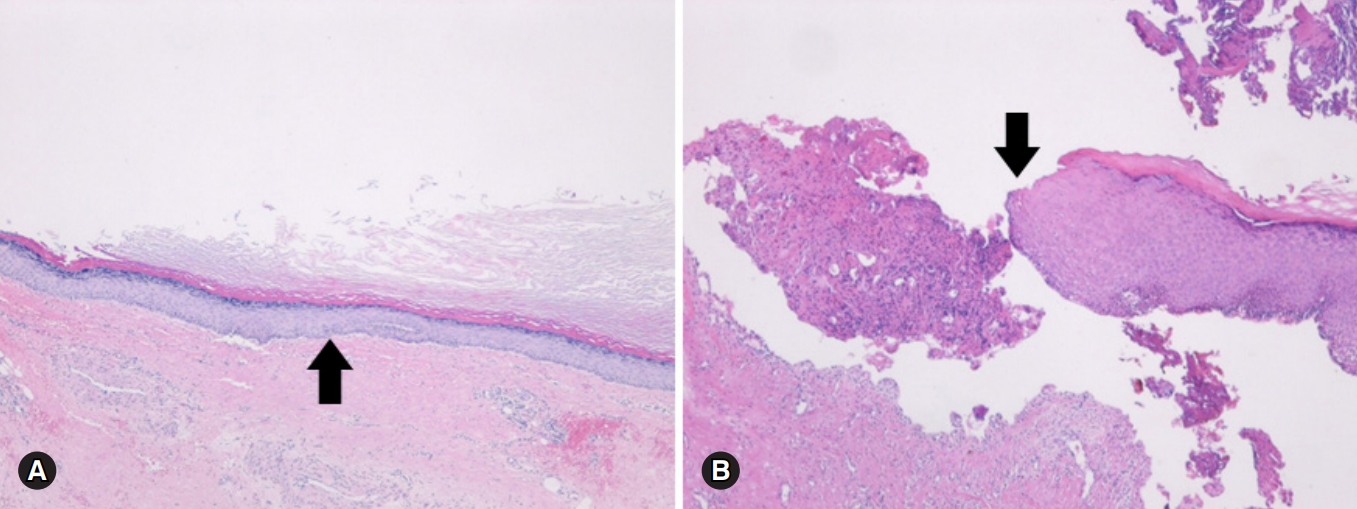
- 8,205 View
- 110 Download
- 4 Crossref
-
 Abstract
Abstract
 PDF
PDF - Background
Epidermal cysts are the most common benign epithelial tumors in humans. The curative treatment of epidermal cyst is surgical excision. However, only few studies have investigated the cause and mechanism of postoperative complications of epidermal cysts. Therefore, this study aimed to evaluate the factors affecting complications of epidermal cyst after surgical treatment.
Methods
Patients with histologically diagnosed epidermal cysts were selected from among 98 consecutive patients with excised benign cystic tumors from March 2014 to August 2017. Sex, age, size, mobility, site of occurrence, history of infection, history of incision and drainage, complications, history of reoperation, and method of overcoming complications was obtained by analyzing medical records retrospectively.
Results
Five of the 98 patients had wound dehiscence due to surgical infection. Three of them underwent wound healing with conservative treatment without a second operation. The other two patients underwent a second operation and showed signs of preoperative infection. None of the factors showed statistical significance in relation to the occurrence of complications.
Conclusion
Postoperative complications occurred when the excision of the epidermal cyst was performed at preoperative infection sites or at sites with high tension, so attention should be paid to postoperative care. -
Citations
Citations to this article as recorded by- Epidermoid cyst in lower lip mimicking Keratoacanthoma: A rare case report
V. Tharani, Nandhini Gunasekaran, K.K. Raja, Ramesh Kumar A
Oral Oncology Reports.2024; 9: 100178. CrossRef - Intradural intramedullary epidermoid cyst in a 17-year-old male: An exceptionally rare case report and review of the literature
Babak Alijani, Sahand Karimzadhagh, Elahe Abbaspour, Zoheir Reihanian, Mohammad Haghani Dogahe, Nooshin Zaresharifi
International Journal of Surgery Case Reports.2024; 116: 109331. CrossRef - Intradiploic Epidermoid Cyst of the Posterior Fossa – Case Report and Review of the Literature
Gonçalo Januário, Bruno Cunha, Ludovica Cellini, Gonçalo Novais
Arquivos Brasileiros de Neurocirurgia: Brazilian Neurosurgery.2023; 42(01): e73. CrossRef - Development of Multiple Epidermal Inclusion Cysts After Radiofrequency Microtenotomy for Plantar Fasciitis: A Case Report
Jennifer Skolnik, Jane Pontious, Todd Hasenstein
The Journal of Foot and Ankle Surgery.2021; 60(5): 1088. CrossRef
- Epidermoid cyst in lower lip mimicking Keratoacanthoma: A rare case report
- Association between cadmium exposure and hearing impairment: a population-based study in Korean adults
- Da Jung Jung
- Yeungnam Univ J Med. 2019;36(2):141-147. Published online April 15, 2019
- DOI: https://doi.org/10.12701/yujm.2019.00178

- 5,123 View
- 78 Download
- 2 Crossref
-
 Abstract
Abstract
 PDF
PDF - Background
The present study aimed to evaluate the clinical association between cadmium exposure and hearing impairment among the Korean population.
Methods
This retrospective cross-sectional study used the data obtained from the Korean National Health and Nutrition Examination Survey were used for our study. Finally, 3,228 participants were included in our study, which were then divided into quartiles based on their blood cadmium levels: first quartile (1Q), second quartile (2Q), third quartile (3Q), and fourth quartile (4Q) groups. The hearing thresholds were measured using an automatic audiometer at 0.5, 1, 2, 3, 4, and 6 kHz. Hearing loss (HL) was defined as >25 dB AHT.
Results
All the groups had 807 participants each. The area under the receiver operating characteristic curves of cadmium level for HL were 0.634 (95% confidence interval [CI], 0.621–0.646). The participants in the 4Q group had higher Low/Mid-Freq, High-Freq, and AHT values than those in the other groups in the multivariate analysis after adjusting for confounding factors. The logistic regression showed that the OR for HL per 1 µg/L increase in cadmium was 1.25 (95% CI, 1.09–1.44; p=0.002) on the multivariate analysis. Moreover, the multivariate logistic regression analyses revealed that the participants in the 4Q group exhibited a 1.59-, 1.38-, and 1.41-fold higher odds for HL than those in the 1Q, 2Q, and 3Q groups, respectively.
Conclusion
High cadmium level quartile was associated with increased hearing thresholds and HL among the Korean adult population. -
Citations
Citations to this article as recorded by- Population‐based study of environmental heavy metal exposure and hearing loss: A systematic review and meta‐analysis
Fang Wang, Frank Böhnke, Katja Böck, Markus Wirth
Laryngoscope Investigative Otolaryngology.2024;[Epub] CrossRef - The role of calcium, Akt and ERK signaling in cadmium-induced hair cell death
Jennifer Galdieri, Chloe Adams, María Padilla, Tamara M. Stawicki
Molecular and Cellular Neuroscience.2023; 124: 103815. CrossRef
- Population‐based study of environmental heavy metal exposure and hearing loss: A systematic review and meta‐analysis
Case reports
- Successful engraftment after infusion of multiple low doses of CD34+ cells from a poorly matched sibling donor in a patient with severe aplastic anemia
- Chang Dae Kum, Mi Jin Lee, Jun Eun Park
- Yeungnam Univ J Med. 2019;36(2):148-151. Published online December 21, 2018
- DOI: https://doi.org/10.12701/yujm.2019.00038

- 5,221 View
- 105 Download
- 1 Crossref
-
 Abstract
Abstract
 PDF
PDF - The dose of CD34+ cells is known to influence the outcome of allogeneic peripheral blood stem cell (PBSC) and/or T-cell-depleted transplantation. A previous study proposed that 2×106 CD34+ cells/kg is the ideal minimum dose for allogeneic transplantation, although lower doses did not preclude successful therapy. In the case we present here, CD34+ cells were collected from a matched sibling donor on the day of allogeneic hematopoietic stem cell transplantation; however, the number of cells was not sufficient for transplantation. Consequently, PBSCs were collected three additional times and were infused along with cord blood cells from the donor that were cryopreserved at birth. The cumulative dose of total nuclear cells and CD34+ cells was 15.9×108 cells/kg and 0.95×106 cells/kg, respectively. White blood cells from this patient were engrafted on day 12. In summary, we report successful engraftment after infusion of multiple low doses of CD34+ cells in a patient with severe aplastic anemia.
-
Citations
Citations to this article as recorded by- Body Surface Area-Based Dosing of Mycophenolate Mofetil in Pediatric Hematopoietic Stem Cell Transplant Recipients: A Prospective Population Pharmacokinetic Study
Hyun Jin Park, Kyung Taek Hong, Nayoung Han, In-Wha Kim, Jung Mi Oh, Hyoung Jin Kang
Pharmaceutics.2023; 15(12): 2741. CrossRef
- Body Surface Area-Based Dosing of Mycophenolate Mofetil in Pediatric Hematopoietic Stem Cell Transplant Recipients: A Prospective Population Pharmacokinetic Study
- Surgical treatment of esotropia and unilateral ptosis in a patient with Cornelia de Lange syndrome
- Won Jae Kim
- Yeungnam Univ J Med. 2019;36(2):152-154. Published online December 17, 2018
- DOI: https://doi.org/10.12701/yujm.2019.00066

- 5,291 View
- 85 Download
-
 Abstract
Abstract
 PDF
PDF - Cornelia de Lange syndrome (CdLS) is a rare multisystemic disorder that is characterized by mental retardation, prenatal and postnatal growth retardation, limb anomalies, and distinctive facial features, which include arched eyebrows that often meet in the middle (synophrys), long eyelashes, low-set ears, small and widely spaced teeth, and a small and upturned nose. Ophthalmic manifestations include long eyelashes, nasolacrimal duct obstruction, myopia, ptosis, and strabismus. There has been no report of surgical treatment for esotropia and unilateral ptosis in patients with CdLS in Korea. We report a patient with CdLS who underwent surgical treatment for esotropia and unilateral ptosis with a good surgical outcome.
- Imatinib-induced hepatitis treated by corticosteroids in a patient with metastatic gastrointestinal stromal tumor
- Min Kyu Kang, Heon Ju Lee, Joon Hyuk Choi
- Yeungnam Univ J Med. 2019;36(2):155-158. Published online January 21, 2019
- DOI: https://doi.org/10.12701/yujm.2019.00115

- 5,179 View
- 83 Download
- 2 Crossref
-
 Abstract
Abstract
 PDF
PDF - Imatinib mesylate is currently used as the first-line treatment for metastatic gastrointestinal stromal tumors (GISTs). Imatinib-induced hepatotoxicity in patients with GIST is very rare. Its features vary from subclinical elevation of serum aminotransferase to clinically apparent acute hepatitis, which is associated with immunologic reactions. Imatinib-induced hepatotoxicity with autoimmune-like features can be treated by the discontinuation of imatinib mesylate and the administration of oral steroids. Here, we report a case of late-onset imatinib-induced hepatitis with autoimmune-like features in a patient with metastatic GIST, which was improved by oral corticosteroids.
-
Citations
Citations to this article as recorded by- The prevalence of hepatic and thyroid toxicity associated with imatinib treatment of chronic myeloid leukaemia: a systematic review
Mansour Tobaiqy, Nawal Helmi, Katie MacLure, Sylvia Saade
International Journal of Clinical Pharmacy.2024; 46(2): 368. CrossRef - Antioxidant-Based Preventive Effect of Phytochemicals on Anticancer Drug-Induced Hepatotoxicity
Ji Eon Park, Chi-Hoon Ahn, Hyo-Jung Lee, Deok Yong Sim, Su Yeon Park, Bonglee Kim, Bum Sang Shim, Dae Young Lee, Sung-Hoon Kim
Antioxidants & Redox Signaling.2023; 38(16-18): 1101. CrossRef
- The prevalence of hepatic and thyroid toxicity associated with imatinib treatment of chronic myeloid leukaemia: a systematic review
- Rapid progression from trochlear nerve palsy to orbital apex syndrome as an initial presentation of advanced gastric cancer
- Eunjung Kong, Sung Ae Koh, Won Jae Kim
- Yeungnam Univ J Med. 2019;36(2):159-162. Published online February 15, 2019
- DOI: https://doi.org/10.12701/yujm.2019.00129
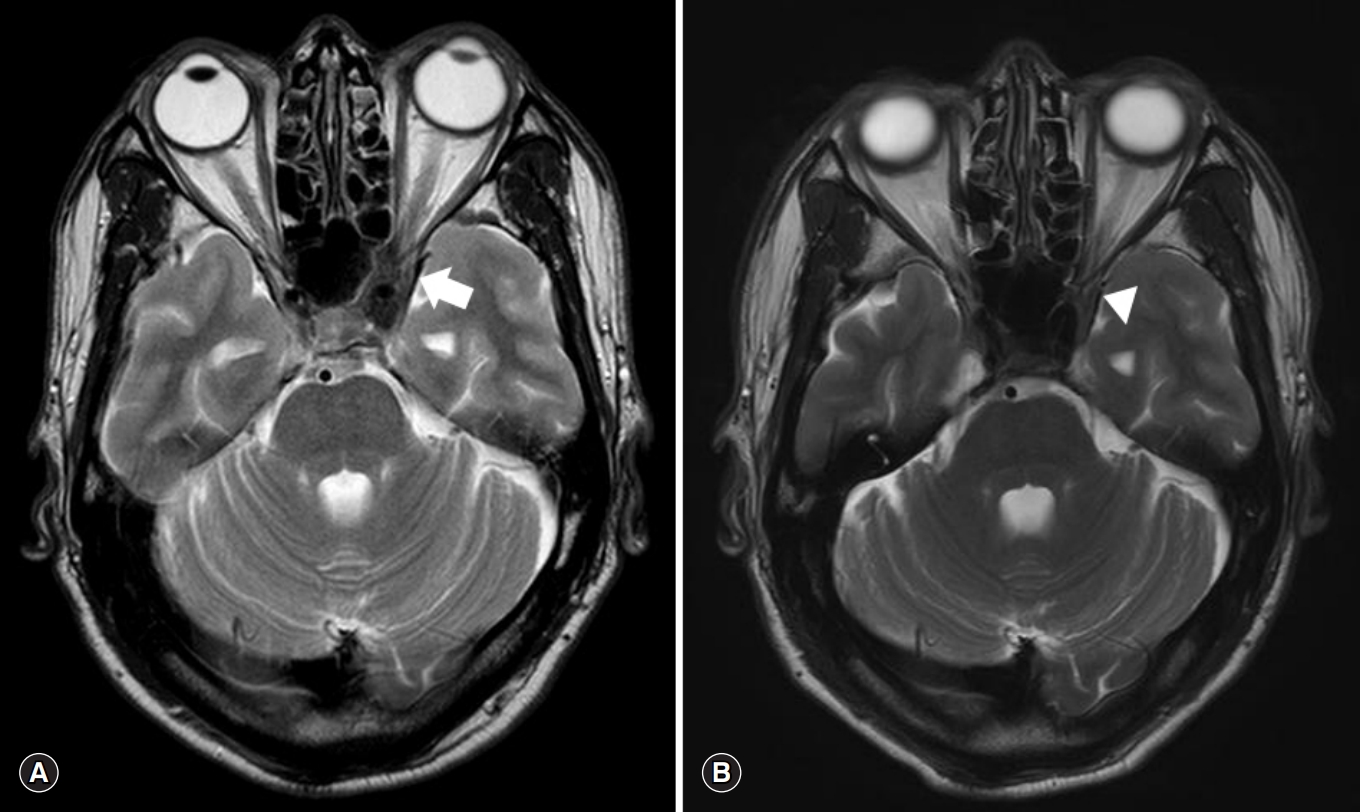
- 4,650 View
- 87 Download
- 1 Crossref
-
 Abstract
Abstract
 PDF
PDF - The most cases with orbital metastases have been reported in patients with a prior established diagnosis of cancer and widespread systemic involvement. However, ocular symptoms can be developed as an initial presentation of cancer in patients without cancer history. We report a case of rapid progression from trochlear nerve palsy to orbital apex syndrome as an initial presentation of advanced gastric cancer.
-
Citations
Citations to this article as recorded by- Neoplastic nerve lesions
Deep K. Patel, Kelly G. Gwathmey
Neurological Sciences.2022; 43(5): 3019. CrossRef
- Neoplastic nerve lesions

 E-Submission
E-Submission Yeungnam University College of Medicine
Yeungnam University College of Medicine


 First
First Prev
Prev



